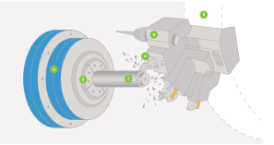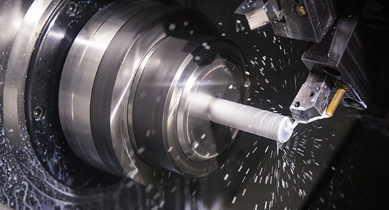CNC turning is a rapid prototyping manufacturing process in which bars of material are held in a chuck and rotated while a tool is fed to the piece to remove material to create the desired shape. A turret, with tooling attached, is programmed to move to the bar of raw material and remove material to create the programmed result. This is also called “subtraction machining” since it involves material removal. If the CNC turning center has both tuning and milling capabilities, such as the one above, the rotation can be stopped to allow for milling out of other shapes.
During the CNC turning process, a metal rod is rotated while a cutting tool is held against the stock to remove material and create final parts. The lathe rapidly machines your parts in a subtractive turning process with additional live tooling. Outside diameter (OD) and inside diameter (ID) threading is also available. Turned parts can then be left as-machined, with visible tool marks, or bead blasted. When the run is complete, parts are inspected, boxed, and shipped shortly thereafter.
The mainly using machine when doing CNC turning is the CNC lathe machine. CNC lathe machines are commonly retrofitted with CNC technology. A CNC lathe machine spins the work-piece in a spindle because of this these machines are perfect for making the parts that have symmetry around some axis. Lathe machines have the least ability to drive the cutting tool under G-code. CNC lathes have replaced the traditional production lathes such as multispindle due to its technological advancement. CNC lathe machines are used in many industries like electronics, automotive, aerospace, firearm manufacturing, etc.

Types of CNC Lathe Machines
As the typical CNC turning machine, lathes can be classified as different standards.
– Based on the number of axes:
1)2-axis CNC Lathe: can perform outer/inner diameter machining, facing, drilling, and tapping.
2)3-axis CNC Lathe: X and Z axis, C axis and live tool system, allowed to perform milling, boring, etc.
3)4-axis CNC Lathe: add Y-axis based on 3-axis machine, for off-center machining operation and complex part
4)5-axis CNC Lathe: add a second turret, allows two tools to work at the same time
CNC lathes or turning centers have tooling mounted on a turret which is computer-controlled. The more tools that the turret can hold, the more options are available for complexities on the part. Some CNC turning centers have one spindle, allowing work to be done all from one side, while other turning centers, such as the one shown above, have two spindles, a main and sub-spindle. A part can be partially machined on the main spindle, moved to the sub-spindle, and have additional work done to the other side of this configuration. There are many different kinds of CNC turning centers with various types of tooling options, spindle options, outer diameter limitations as well as power and speed capabilities that affect the types of parts that can be economically made on it. However, as there various pros and cons of using a CNC lathe, we focus on trying to mitigate the latter while emphasizing the other.

CNC Lathe/CNC Turning Advantages and Disadvantages
Pros -
Fast and Easy: CNC turning ensures a fast, easy, and reliable operation of the machine with no physical labor but a command required.
Accuracy and Smoothness: CNC turning parts are tested and refined so as to give the best quality service lacking nothing in accuracy and smoothness.
Efficiency: A press of a button is all that required for delivering a task or various others of the same type, simultaneously.
Low Cost: CNC turning parts are efficient and low cost oriented as a result of less involvement of labour.No operator required during the operation process.
Easy Upgrade: Only a software update is required to upgrade the machine
Cons -
Expensive Machine: Though CNC lathes are usually expensive, we try to ensure ours is cost-efficient and affordable at a lower price than others.
Periodical Maintenance Cost: CNC turning parts are produced by expert and skillful professionals using the best quality raw materials and tools for ensuring durability and versatility.
New Programming: Though there is a need for separate command for a separate task, The need for new programming and command for separate tasks are facilitated in an easy manner.
Need for Skilled Operator: CNC turning parts are programmed and made in an easy to use manner which only needs a person with thorough computer knowledge and skill to operate.
Tuowei CNC turning process produces custom rapid prototypes and end-use production parts in as fast as 1 day. We use a CNC lathe with live tooling so features like axial and radial holes, flats, grooves, and slots can be machined. Tuowei prototype’ CNC machining service can deliver machined parts, in both plastic and metal, in less time than it takes to get a quote from other, more traditional machine shops. Upload a CAD file, choose the material and part quantity, and tell us when you need the parts.
Any needs, please let me know and contact us, we will provide fast and reasonable prices for you. Our email is: towell@sztuowei.com

